The paths of Jaguar and Land Rover, both throughout their past and towards their future, are inexorably tied together. Since they were joined under the notorious British Leyland corporation in 1968, the companies were inseparable, and even after Jaguar was spun off in 1984 and then bought over by Ford in 1989, it was reunited with Land Rover when Ford purchased the SUV maker from BMW in 2000.
Now under the Tata umbrella, the two form a common entity, sharing components, engines and production sites. It seems like the ideal union – although both cater to a similar upper middle class demographic, they serve two completely different markets, with one building fast, discreet sports cars and luxury sedans, and the other churning out tough, dependable off-roaders. They complement each other perfectly.
Or so we thought. Just a few years after the merger, we heard rumours that the Leaping Cat was going to build (gasp!) an SUV. Rubbish, we thought – the very idea that Jaguar would make a product that could very well cannibalise sales from its sister brand was absurd in itself. But then in 2013, the company revealed the C-X17 concept, the progenitor of a go-anywhere Jag – and suddenly the prospect seemed very real.
And so we come to the Jaguar F-Pace that we see here, the production version of the show car. Coventry is very aware of the elephant in the room, and it has pushed the compact SUV’s sporting aspects – including tenuous links to the F-Type sports car – rather than the all-terrain capabilities that are Land Rover’s bread and butter. But is there really enough room for two British SUVs in the same market? More to the point, is Jaguar’s first ever SUV actually any good? That’s why we’re here in Montenegro to drive it, to find out.
The first thing you have to know about the Jaguar F-Pace is that it’s not just a Land Rover in an evening gown, a necklace and high heels. Instead, it uses the same aluminium-intensive architecture employed by its XE and XF sedan siblings, rather than the more rugged, predominantly steel D8 platform used on the closest Land Rover in terms of size and price, the Discovery Sport. So, it’s a road car, first and foremost – not an off-roader that just happens to have pleasing road manners.
Its sportier, more road-biased positioning is readily apparent, not least in terms of the kind of competing models that Jaguar considers as rivals. During presentations and throughout the drive, the company insists that the F-Pace’s direct rival is the Porsche Macan – the closest in concept to what the marketers rather awfully term a “practical sports car.” More mainstream models such as the BMW X3, Mercedes-Benz GLC, Audi Q5 and Lexus NX exist in the gunsights too, of course, but only in the periphery.
Confusingly, the F-Pace is significantly bigger than all its rivals. At 4,731 mm long, 1,936 mm wide and 1,652 mm tall – with a 2,874 mm wheelbase – it’s 50 mm longer than the Macan, 75 mm longer than the GLC, 79 mm longer than the X3, 92 mm longer than the Q5 and a whole 101 mm longer than the Lexus NX.
It’s also wider than all of those, and only the X3 and Q5 are taller. Crucially, however, the F-Pace does stop a fair bit short from ending up in the next class, where heavy hitters like the BMW X5 and Mercedes-Benz GLE reside – although the Jaguar’s considerable width is comparable to those two.
Right, on to the looks. The F-Pace’s styling is very clearly Jaguar, utilising a design language that traces its roots from as far back as 2007, on the C-XF concept. At the front, there are sleek, sharp headlights – with either bi-xenon or full-LED units available as options – that flank a large, simple rectangular grille, while massive side scoops join a smaller centre inlet.
Move towards the sides of the car, and you’ll notice that while the brand’s characteristic teardrop-shaped glasshouse and fender vents are present, the continuous shoulder line that links the front and rear of Jaguar’s sedans is missing. Instead, the swooping line that begins from the front fender fades off into the doors, the slack being taken up by punchy rear haunches instead.
Jaguar says that while the unbroken shoulder line helps lengthen a sedan visually, such cues would not work on a taller SUV. Instead, the designers took a page from the F-Type’s voluptuous rump to give the F-Pace a more dynamic appearance. Other cues lifted from the sports car include the slim LED tail lights, with a semi-circular kink that is mirrored in the light tube running along the lower edge.
Those who would like a sportier edge to the looks can opt for the R-Sport models, which gain body-coloured lower inserts (instead of black on the standard F-Pace) and a more aggressive front bumper design. Also thrown in are an R-Sport leather steering wheel, sports seats and R-Sport-branded metal sill plates.
More powerful F-Pace S variants get the R-Sport kit as standard, but delete the side air intakes’ horizontal rib and add a diffuser-like rear valence with twin exhaust exits. On all models, you can select from a wide range of alloy wheels that measure between 18 and 22 inches.
But if exclusivity is your thing, the First Edition is your best bet. Essentially a gussied-up F-Pace S, it receives gloss black fender vents and a matte grey finish for the standard 22-inch Double Helix alloys, along with the availability of Caesium Blue and Halcyon Gold paint options – both hues were used on the C-X17 at the 2013 Frankfurt and Guangzhou motor shows respectively.
Elsewhere, a panoramic sunroof and LED headlights are also standard fit, while the interior gains Windsor Light Oyster leather upholstery with an embossed houndstooth motif on the seat centre panels – this pattern can also be found on the door trim strips. It’s very unlikely that the First Edition will be offered in our market, however, as it is strictly limited to only 2,000 units globally.
If the cabin looks very familiar, that’s because the upper dashboard is lifted straight from the XE, with other main components also carried over from new-age Jaguars. The company claims that it wants to establish a common look for its interiors before it can afford to differentiate its models further, but three models into the new lineup and already the cockpits of all its cars are starting to look a little too identical.
There are unique parts to the F-Pace’s interior, however. These include the door cards, which gain discrete grab handles and relocated window switches on the door tops (à la Land Rover), while the wraparound dash panel loses the sedans’ decorative trim that runs around the upper dash. The taller spars along the centre console, now with small storage compartments along the sides to store your odds and ends, are also new.
Build quality is about par for the course for the premium compact segment – which is to say decent, but not mind-blowing. The upper dash is quite pleasant to look at and to touch, but even though the lower portions are leather-wrapped on the cars we are driving, they are incredibly stiff when rapped, and the armrest is rather uncomfortable to, you know, actually rest your arm on.
Some of the interior trim pieces, including the decorative door trim, also feel downright cheap – the black-and-silver houndstooth panels on the supposedly most luxurious First Edition being a particularly offending example. Outward visibility is poor as well, with thick A-pillars and a letterbox slot for a rear windscreen all conspiring to obstruct your view.
However, there’s little to grumble about in terms of space. Both front and rear occupants get plenty of head-, leg- and shoulder room to spare, likely thanks to the car’s considerable size advantage over the competition – and the rear seats even get an electric reclining function for even more back seat comfort. The boot is also capacious, measuring 650 litres when other rivals offer around 100 litres less – and you can fold the 40:20:40-split seats flat to boost space still further to an impressive 1,740 litres.
Plenty of toys are on offer as well. The base InControl Touch infotainment system comes with an eight-inch touchscreen, which is already as large as many of its competitors’ upgraded displays. Step up to the InControl Touch Pro system – which runs on a quad-core processor, a high-speed Ethernet network and a 60 GB solid state drive (SSD) – and you’ll get a massive 10.2-inch widescreen display.
With all that firepower packed underneath, it’s no surprise that the upgraded system feels slick, browsing through the menus at lightning speed. That impression is aided by the capacitive multitouch display that allows for more natural scrolling and pinch-to-zoom. It’s not perfect, however – the main menu relies mostly on imagery instead of clear, simple iconography for the different functions, so it does make navigating through it a bit confusing at first. Some hard shortcut buttons would also come in handy.
The Pro system also tacks on a 12.3-inch virtual instrument cluster that replaces traditional analogue gauges, complete with four different display themes. Like Audi’s virtual cockpit, the screen can also be configured to show a full navigation display, but unlike the Ingolstadt system, you don’t get minimised versions of the speedometer and rev counter – just a small speed readout.
Other features include a WiFi hotspot function for up to eight devices, as well as the ability to lock the doors, pre-cool the interior and locate the car using beeps and light flashes, all through the InControl Remote Premium apps. You can also pair the infotainment system to one of two optional Meridian sound systems – a 380 W, 11-speaker system and an 825 W, 17-speaker surround sound system.
A key accessory that Jaguar is proud to show off is the optional Activity Key, a waterproof and shockproof wristband that allows you to lock the standard key fob in the car when it is inconvenient to carry it on your person, such as when you’re cycling, swimming or surfing. It uses no batteries, just an RFID chip that simply needs to be placed close to the ‘J’ of the Jaguar badging on the tailgate to lock the car – by doing so, you’ll also disable any key left inside the vehicle, thwarting potential thieves.
Safety kit, as you’d expect in this class, is vast and includes several driver assist systems such as Autonomous Emergency Braking (AEB) – which, on the F-Pace, comes with pedestrian detection, a Jaguar first – along with lane departure warning, lane keep assist, traffic sign recognition with an intelligent speed limiter, adaptive cruise control with queue assist, a blind spot monitor and reverse traffic detection.
At launch, only three engines are on offer, and the only one that has been confirmed for the Malaysian market so far is the range-topping 3.0 litre supercharged petrol V6 – taken from the F-Type, no less. Two outputs are on offer – the standard engine produces 340 PS at 6,500 rpm and 450 Nm of torque at 4,500 rpm, while the more powerful version available only on the F-Pace S bumps power to a healthy 380 PS.
A smaller petrol engine – particularly with our capacity-based road tax system – would be far more popular over here, but a 2.0 litre turbo mill is only expected to be offered on the F-Pace once production starts on petrol engines from Jaguar Land Rover’s new, currently diesel-only Ingenium modular engine family. That’s slated for the middle of this year, although details have yet to be announced so far.
On the diesel side, there’s the 3.0 litre twin-turbo V6 that’s also available on the F-Pace S, pushing out 300 PS at 4,000 rpm and 700 Nm at 2,000 rpm. Further down the range is the Ingenium 2.0 litre four-cylinder turbodiesel that develops 180 PS at 4,000 rpm and 430 Nm between 1,750 rpm and 2,500 rpm.
Both V6 mills come standard with a ZF eight-speed automatic transmission and all-wheel drive; the Ingenium diesel is available with either the automatic with all-wheel drive, or a six-speed manual transmission with a choice of either rear-wheel drive or all-wheel drive.
The F-Pace’s on-demand all-wheel drive system is derived from the one on the F-Type – it defaults to a rear-wheel drive setup in normal driving conditions, but can send up to 50% of its torque to the front wheels when needed in just 165 milliseconds thanks to Intelligent Driveline Dynamics (IDD).
Also nicked from the F-Type is a standard-fit brake-applied torque vectoring system, which brakes the inside wheels upon corner entry to prevent understeer. Jaguar claims the system works predominantly on the rear wheels to prevent the corruption of steering feel.
Other chassis electronics serve to enhance the F-Pace’s off-road capabilities. These include the Adaptive Surface Response (AdSR), a system that adapts the throttle, transmission and stability control mapping according to the given terrain to maximise traction, much like Land Rover’s Terrain Response system. The second-generation XF was the first to use the system, but the F-Pace adds a new mode – one for high-drag surfaces such as deep snow or gravel – to go with the existing snow/ice and gravel/wet tarmac settings.
Two other off-roading features are only available on models with the automatic transmission. The first is All-Surface Progress Control (ASPC), a sort of low-speed cruise control which applies the brakes to enable very low torque application over slippery terrain, ensuring smooth progress with little to no wheel spin. The other, Low Friction Launch (LFL), is similar in concept to ASPC, except that it instead uses a more progressive throttle map to enable drivers to pull away cleanly and smoothly by themselves.
Under the skin, the F-Pace’s monocoque bodyshell is made from 80% aluminium, with a third of that made from JLR-developed RC5754 aluminium that is predominantly recycled – Jaguar’s goal is to use as much as 75% of recycled aluminium in the construction of its body structures by the year 2020. You’ll find steel in there, too, but it’s only used in the doors and the boot floor, mainly to improve weight distribution.
Together with the magnesium front end carrier and composite tailgate, the lightweight construction allows the base F-Pace with a 2.0 litre diesel, a manual gearbox and rear-wheel drive to weigh in at just 1,665 kg – that’s lighter than an equivalent BMW 5 Series, for example. Spec-for-spec, the car is lighter than most of its rivals, despite being quite a bit larger than all of them.
Parts of the structure have been revised to make the F-Pace more suited to off-road duty, including die cast aluminium front suspension turrets that have been redesigned to increase suspension travel and ground clearance. The front crossmembers are also larger and stiffer, the subframes and their mounting points have been redeveloped, and each bracket has been optimised wherever possible, all to improve body stiffness.
The F-Pace sits on a similar double wishbone front suspension system as the F-Type, but like the body structure, it has been revised to suit an SUV’s broader set of capabilities. The lower suspension arms have been designed to prevent against accidental grounding, while the anti-roll bar bushes are bonded for improved resistance to dirt and sand. The steering is an electrically-assisted, variable-ratio unit.
At the rear of the car sits Jaguar’s Integral Link rear suspension, which made its debut on the XE – the multilink design, unique to Coventry, separates lateral and longitudinal stiffnesses, enabling the suspension to be tuned for both a calmer ride and more responsive handling. Adaptive Dynamics active suspension is available as an option.
Driving out of the Kotor Bay ferry that marks the start of the drive (yes, really), the F-Pace immediately feels agile and nimble – the lightweight construction must be paying dividends here. Rare it is for a car this big to feel so reactive and responsive – the closest thing this writer has driven is the Mercedes-Benz GLE 450 AMG Coupe, and while that one is certainly very competent dynamically, it pales in comparison to the Jaguar.
As I start to push it harder, the quick and direct steering is immediately apparent, as is a fluidity and weightiness across the rack that is very pleasant. The chassis feels eager to turn in, never really succumbing to understeer on these tight Montenegrin mountain roads, and body movements are reigned in nicely.
You can tighten it up still further by selecting the harder Dynamic mode, but even in Comfort mode there’s a good amount of firmness in the corners. Our only gripe is a curious lack of grip on the rain-slicked roads throughout the atrocious weather we are experiencing here – more than once does the traction control cut the throttle as I power out of the many hairpins that dot the drive route.
This amicable dynamic attitude allows you to build a rapport with it, and encourages you to push harder, faster through winding roads that would’ve long made mincemeat out of other competitors. One particularly memorable moment was when I was following another F-Pace up a particularly twisty section that led to the Lovcen National Park, which made for a very entertaining drive – right until my drive partner lost his lunch.
Fortunately, the F-Pace’s impressive handling ability doesn’t impinge on comfort. Even as we encounter rutted rural roads and gravelled lanes, the car maintains an impressive level of composure – this despite the 22-inch wheels on the First Edition that we drive. More importantly, selecting Dynamic mode doesn’t cause the ride quality to fall into pieces. You can feel the increased firmness, but it never gets uncomfortable.
Two engine variants were available for us to test in Montenegro. The Ingenium 2.0 litre diesel is expected to be a global volume seller – although it is unlikely to be offered in Malaysia – and it impresses with its strong low- and mid-range punch, belying its tepid power figure.
The oil-burner revs surprisingly cleanly up to the redline, too, and also remains very refined as you do so – the typical gravelly diesel rattle is almost non-existent inside, and it makes a not entirely unpleasant grumble as you get up on it. Noise levels are also kept to a minimum, with very little road roar to speak of even on massive wheels and tyres, and only a touch of wind noise at higher speeds.
Its impeccable manners are further refined through the eight-speed automatic – the ZF unit has always been fantastic, and it shines here too, with fast, buttery smooth shifts no matter what the condition. Sometimes, its reactions – especially under kickdown – is not as quick as the best of them, including the same transmission in BMWs, but you can always use the lovely metal paddle shifters to quicken its pace.
But of course, if you want the ultimate F-Pace – rumoured upcoming hot SVR version notwithstanding – then the S variant with the 380 PS 3.0 litre supercharged petrol V6 will have to be it. There’s not quite the immediate low-end push of the diesel; you’ll have to floor the throttle and drop a few gears to get past slow traffic, but do that and by god will it fly.
This excellent turn of pace is mirrored in the performance figures – the sprint to 100 km/h takes just 5.5 seconds, and the F-Pace S will go all the way to an electronically-limited top speed of 250 km/h. Further pumping up the heart rate is an excellent soundtrack, with a rorty growl from the exhaust as the engine surges up the rev range – it’s a real treat, particularly when gunning it through the route’s myriad of tunnels.
The only downside with choosing the large petrol engine – aside from the expected astronomical fuel bills, of course – is the greater mass over the front wheels compared to the lighter four-pot, so it does dull the steering and turn-in just a little bit. Still, it’s a fantastic car to drive, all things considered.
We also get to try the F-Pace off road, driving up and down a steep, grassy hill and across the rocky mountains, the trail muddied from all that rain. There’s even a death-defying ramp that leads straight down from the Slansko Lake dam to test out the ASPC’s hill descent feature.
The system works brilliantly across all surfaces – it’s a little disconcerting at first to watch the car slither its way up and down a near-vertical slope without touching the pedals, but you’ll soon learn to trust the system as it crawls through ruts and bumps that would have easily left you stranded. The 520 mm maximum water wading depth, achieved through a raised air intake positioning, is impressive as well.
Let’s face it, most F-Pace buyers won’t go anywhere the terrain seen here, but the fact that Jaguar has managed to bake near-Land Rover levels of capability into a vehicle that’s very clearly meant to be used on the road is commendable nonetheless.
At the end of the day, the new Jaguar F-Pace is a deeply impressive machine. The engineers clearly have worked hard to create a fast, engaging, genuinely capable machine, and clad it in a gorgeous design that is every bit as desirable as a Jaguar should be – all without forgetting the sort of active types and families that require the space and practicality of these SUVs in the first place.
The public debate on whether JLR can afford to have both of its brands building SUVs will surely continue, but on this instance it appears that there’s plenty of room for a sporty, dynamic offering to sit next to a true go-anywhere off-roader in the group’s lineup. And judging by the confidence of the engineers who are present at the drive – many of which are shared between the two brands – it seems that the company thinks so too.
The Jaguar F-Pace is expected to arrive in Malaysia in the fourth quarter of 2016.
Looking to sell your car? Sell it with Carro.


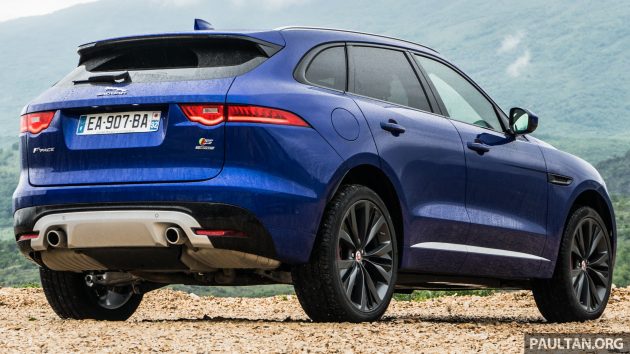








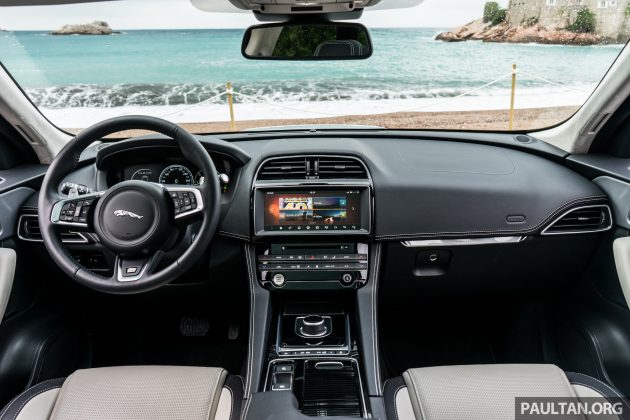







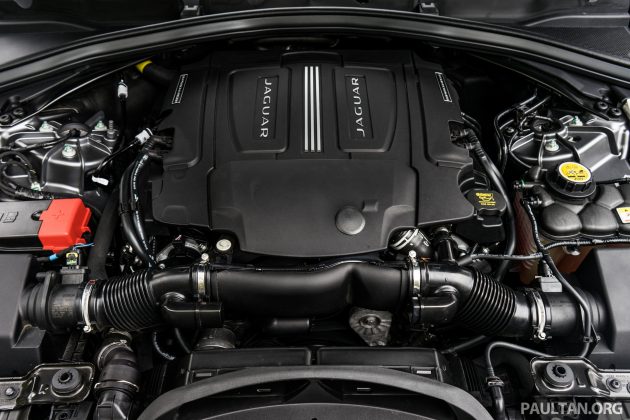



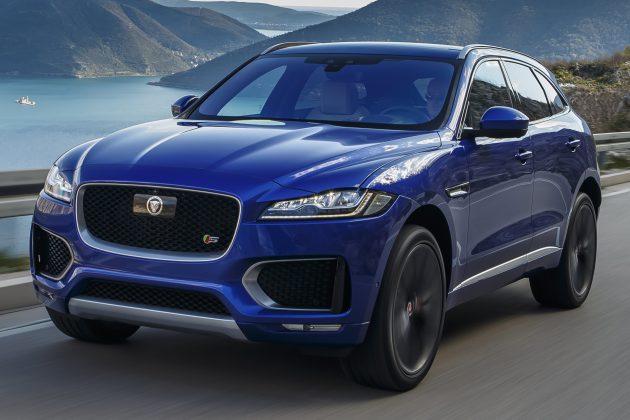
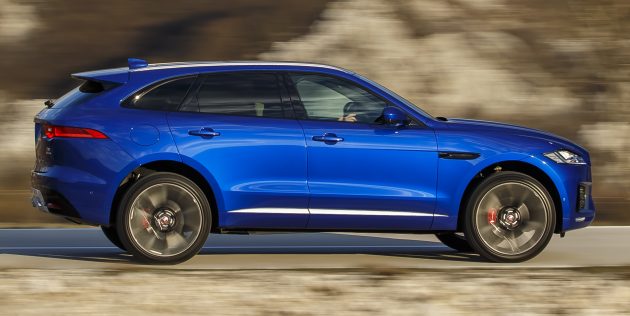



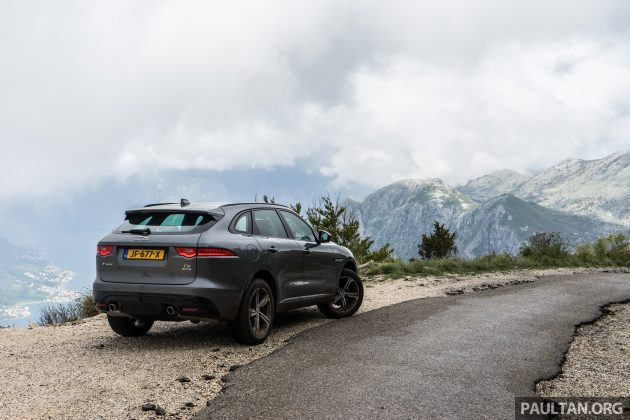




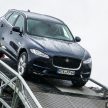
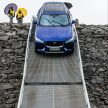


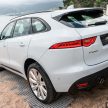









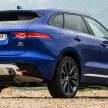
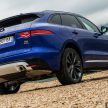



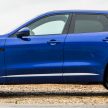

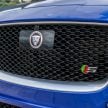


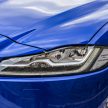
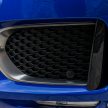
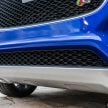
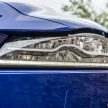
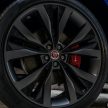
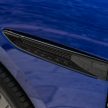
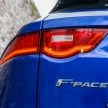
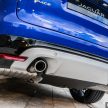
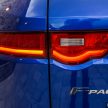

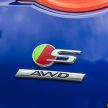
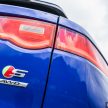

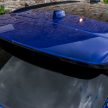

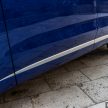
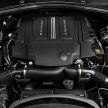
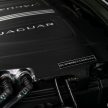
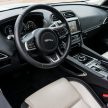
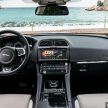
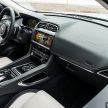
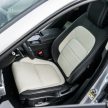
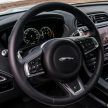
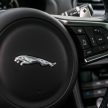
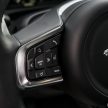
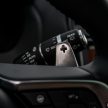
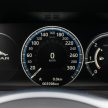
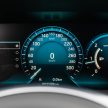
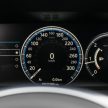

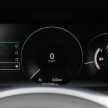
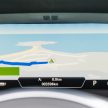
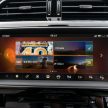
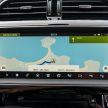
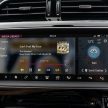
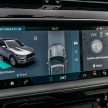
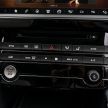
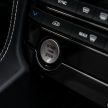
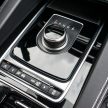
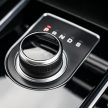
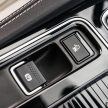
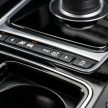
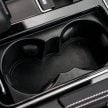
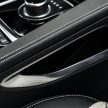
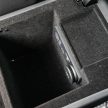
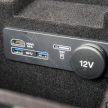
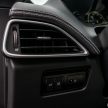
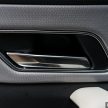
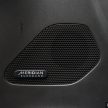
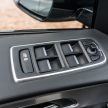
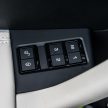

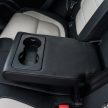
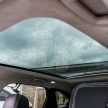
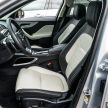
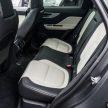
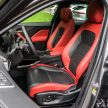

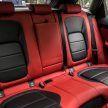
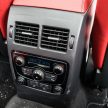

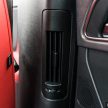
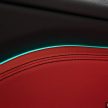
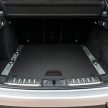
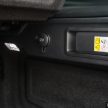
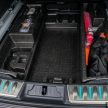







Jaguar xf naturally competes with gs 5 e and a6 so since they use the alphabet f-pace it should be competing against rx x5 gle and not nx x3 glc and q5…the e-pace is coming out soon and as one can see the xe competes with is 3 c and a4…and so naturally xe will compete against nx x3 glc and q5…now back to you jonathan…
The F-Pace moniker – at least according to the people I spoke to during the drive – is not strictly used to denote the car’s positioning in the market place, but rather it’s meant to give it a link to the F-Type, no matter how pretentious that may be.
The F-Pace’s dimensions actually puts it between the BMW X3/Mercedes GLC/Audi Q5/Lexus NX and the BMW X5/Mercedes GLE/Lexus RX, probably to give it a generation advantage against its natural competitors, as the upcoming G01 BMW X3 and next-gen Audi Q5 should grow into the Jaguar’s size.
We expect the rumoured E-Pace to fall closer towards the BMW X1 and Mercedes GLA, as well as base versions of the X3 and GLC.
That explains the letterbox rear windscreen and thick A pillars. Cos they want to make you feel as though you’re in the F Type. A very tall F Type.
Where is our Proton SUV? CEO of Proton told us Proton SUV coming out. Bila lah bang?
Perdana also we are waiting. People are so fed up with Proton. How long you want to test? It is just rebadging bang. Tak kan rebadging also must take so long to test.
Only moving coffins do short tests
Volvo XC60 > all.
Europe’s bestseller premium mid-size SUV, beauty, comfort, safety, power, economy, reliable, value for money, practicality, it has all of it.
Jon, Jon… u forgot the king of this segment? Compare with other dirty peasants, forgot the masterrace Volvo?
*lie down, try not to cry, cry a lot*
first quarter 2016? lol already 2nd quarter
Ah, right, sorry about that! It was supposed to be the fourth quarter, as reported earlier. The article has since been amended.
Thanks for the spot!
The cabin is a letdown. Also the engine choice has a massive performance/ price gap, there’s no middle ground. Altho a bit cramped in the back, the Macan S is so much better
wonder if our cars will be fitted with 22-inch alloys as well. that’s some seriously big alloys!!
the centre stack is just too meh, myvi clioqsque ,
Very nice car, in a very scenic location. Great photos too. The F Pace is one of the most handsome SUVs around. I think better looking than the Macan. The side profile reminds me of the 1st generation BMW X1 (though it was lower slung – like a crossover wagon, rather than SUV), with the extra long hood, and short front overhang, like a tall 3 Series Wagon. The Maserati Levante has the same basic design principles too, but somehow the end product looks ungainly in my opinion.
And the fact it drivers brilliantly (on road), based on reviews I’ve read and watched, makes it even better. It’s actually a half size larger than the X3/X4, GLC, Macan rivals. Half because it isn’t quite as big as the X5/X6, GLE, Cayenne, which are a size up. So the F Pace has better interior room than the Beemer and definitely more than the tight-ish Macan. But I think maybe it matches the GLC for interior space (except width) – Mercedes is just good at space maximisation. And that huge boot is a big bonus. Now you can have your cake and eat it too. Or not quite. The ergonomics is poor. Thick A pillars and AC vents that are too low on the dash. They may freeze your hands more than your body. And hard armrests? That’s just weird for a brand synonymous with luxury. Just curious, how’s the sound quality of the top spec Meridian surround hifi?
Didn’t really have a chance to test it, as it was turned off during the drive – the soundtrack of the supercharged V6 was just too delicious not to savour fully!
I tested the F Pace 825w stereo today. My reference is the audio system on the 2016 Acura MDX with the Technology package. I was very disappointed with the jag’s Meridian system. The subwoofer produces a muffeled sloppy slow base sound. It’s so bad, I had to turn it to the lowest level possible. I compensated for the sub by increasing the base a little from neutral. The quality of sound from the “Meridian”, “dolby” and “DTS” modes is por with each mode creating an artificial sound stage. The “Stereo” mode sounds best. I played acoustic, vocal and rock music via an iphone connected via USB. The tracks were all high quality. The Meridian system sounded just like the average stereo on late model Hondas and Toyotas. There was no hint of anything close to high fidelity. I had the jag sales guy listen to the Meridian and then listen to the Acura. He was blown away by the high quality, near audiophile quality of the Acura. I’m now rethinking my plan to order a new F Pace. Clearly, the F Pace is a higher quality and better performing driving machine but the stereo system is of inferior quality.
as much as I like this car, I think is the wrong move.
JLR already achieved reputable sales in this segment with the Evoque. Why go and disturb its own market segment?
The resources are better to invest in an all-new Evoque and build on the success.